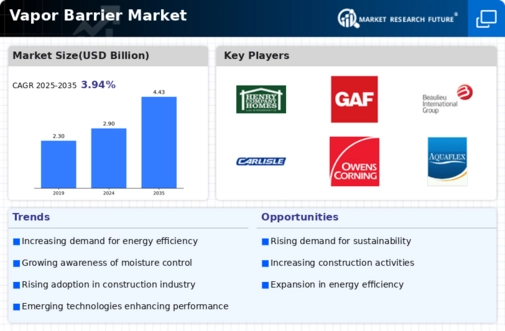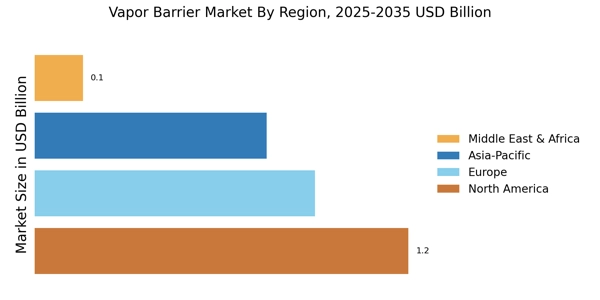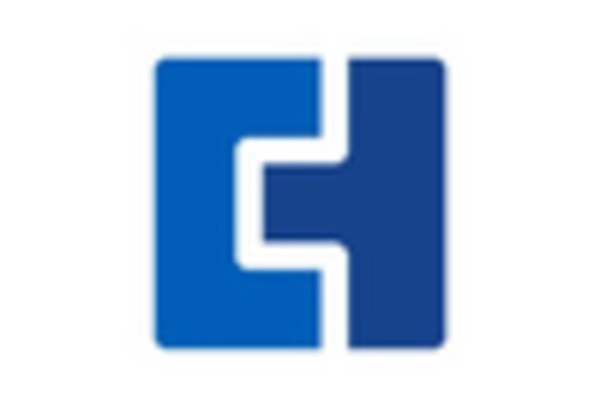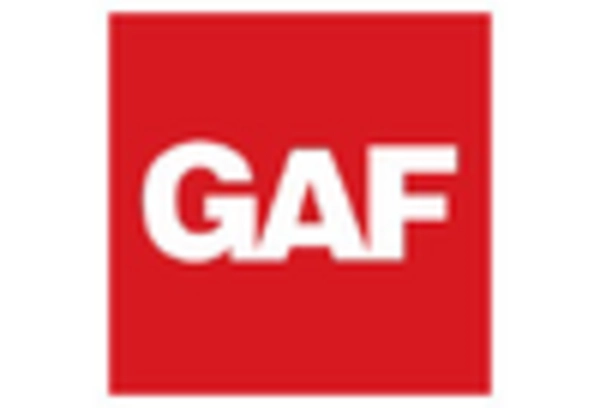Rising Construction Activities
The increasing construction activities across various sectors, including residential, commercial, and industrial, appear to be a primary driver for the Vapor Barrier Market. As urbanization accelerates, the demand for effective moisture control solutions in buildings intensifies. In 2025, the construction sector is projected to grow at a rate of approximately 5.5% annually, leading to a heightened need for vapor barriers to prevent moisture-related issues. This growth is particularly evident in regions experiencing rapid population growth, where new housing developments necessitate the implementation of vapor barriers to ensure structural integrity and longevity. Consequently, the Vapor Barrier Market is likely to benefit from this trend, as builders and contractors increasingly recognize the importance of moisture management in construction projects.
Technological Innovations in Materials
Technological advancements in materials science are reshaping the Vapor Barrier Market. Innovations such as the development of advanced polymer films and breathable membranes are enhancing the performance and applicability of vapor barriers. These new materials offer improved durability, flexibility, and moisture resistance, making them more appealing to builders and architects. In 2025, the market for advanced vapor barrier materials is expected to expand significantly, driven by the construction industry's demand for high-performance solutions. This trend suggests that the Vapor Barrier Market is likely to witness increased competition among manufacturers, as they strive to introduce cutting-edge products that meet the evolving needs of the construction sector.
Regulatory Standards and Building Codes
The implementation of stringent regulatory standards and building codes is significantly influencing the Vapor Barrier Market. Governments and regulatory bodies are increasingly mandating the use of vapor barriers in construction to ensure safety and durability. These regulations are often aimed at reducing moisture-related problems, which can lead to structural damage and health issues. In 2025, it is anticipated that compliance with these standards will drive a substantial increase in the demand for vapor barriers, as builders strive to meet legal requirements. This regulatory landscape not only enhances the credibility of the Vapor Barrier Market but also encourages innovation in product development, as manufacturers seek to create solutions that comply with evolving standards.
Increased Awareness of Energy Efficiency
The growing awareness of energy efficiency and its impact on building performance is driving the Vapor Barrier Market. As energy costs continue to rise, property owners and builders are seeking solutions that enhance insulation and reduce energy consumption. Vapor barriers play a crucial role in maintaining optimal indoor climates by preventing moisture infiltration, which can lead to energy loss. In 2025, it is estimated that the energy-efficient building materials market will reach a valuation of over 300 billion dollars, with vapor barriers being a key component. This trend indicates a shift towards sustainable building practices, where the Vapor Barrier Market is positioned to thrive as stakeholders prioritize energy-efficient solutions in their construction and renovation projects.
Growing Demand for Sustainable Building Practices
The rising demand for sustainable building practices is a crucial driver for the Vapor Barrier Market. As environmental concerns gain prominence, builders and developers are increasingly adopting eco-friendly materials and methods. Vapor barriers contribute to sustainability by enhancing energy efficiency and reducing the carbon footprint of buildings. In 2025, the market for sustainable construction materials is projected to grow at a compound annual growth rate of around 7%, indicating a robust shift towards environmentally responsible building practices. This trend positions the Vapor Barrier Market favorably, as stakeholders seek solutions that align with their sustainability goals while ensuring the longevity and performance of their structures.


















Leave a Comment